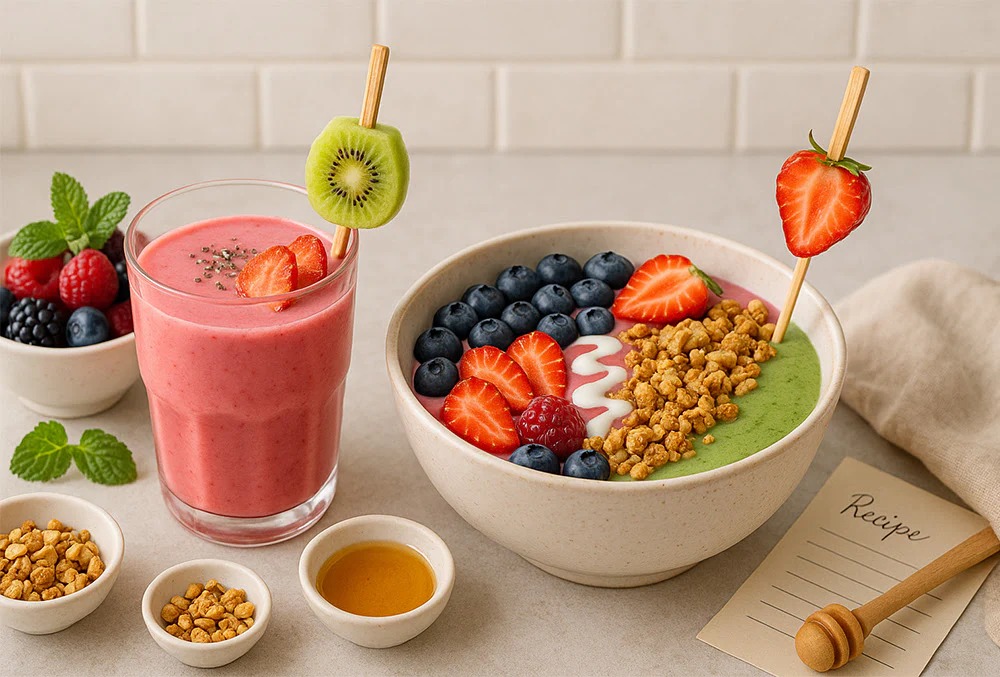
Smoothies are my go-to breakfast when I’m craving something quick, refreshing, and packed with nutrients. I remember the first time I tried making one at home—excitedly tossing in every fruit I had, from bananas to berries to a questionable kiwi that had been sitting in the fridge a bit too long. The result? A weirdly sour, gritty mess that made me wonder if I’d accidentally invented a new kind of soup. That’s when I realized: mixing fruits for smoothies isn’t just about throwing everything into a blender. There’s an art and science to it, especially when it comes to doing it safely and creating blends that taste amazing and nourish your body. In this guide, I’ll walk you through everything you need to know about mixing fruits safely for smoothies, from choosing the freshest produce to avoiding common pitfalls, all while keeping things fun and flavorful. Let’s dive in!
Why Safe Fruit Mixing Matters
Smoothies are often hailed as a health-boosting powerhouse, but blending fruits carelessly can lead to issues like foodborne illness, nutrient loss, or even digestive discomfort. I learned this the hard way when I once blended a moldy strawberry into my smoothie, thinking, “It’s just one bad spot!” Spoiler: it wasn’t worth it. Safe fruit mixing ensures your smoothies are not only delicious but also free from harmful bacteria, excessive sugars, or combinations that could upset your stomach. By following a few simple guidelines, you can elevate your smoothie game while keeping health first.
The Risks of Unsafe Fruit Handling
Improperly handled fruits can harbor bacteria like E. coli or Salmonella, especially if they’re not washed properly. According to the CDC, contaminated produce is a leading cause of foodborne illness. Additionally, mixing certain fruits can lead to digestive issues due to differing digestion rates, and overripe or spoiled fruits can introduce toxins. Let’s break down how to avoid these risks and create smoothies that are both safe and scrumptious.
Choosing the Right Fruits for Your Smoothie
The foundation of any great smoothie is fresh, high-quality fruit. I’ll never forget the time I tried using a mushy, overripe mango—let’s just say the texture was more “swamp” than “smoothie.” Selecting the right fruits is crucial for flavor, texture, and safety. Here’s how to pick the best ones:
- Check for Freshness: Look for vibrant colors, firm textures, and no signs of mold or bruising. For example, ripe bananas should be yellow with a few brown spots, not completely black. The USDA recommends inspecting produce for any unusual odors or soft spots, which can indicate spoilage.
- Opt for Seasonal Fruits: Seasonal fruits are fresher, tastier, and often more affordable. A summer smoothie with fresh peaches or a fall blend with crisp apples will always taste better than out-of-season imports. Check Eat Seasonably for a guide to what’s in season.
- Consider Frozen Fruits: Frozen fruits are a great option, especially for busy mornings. They’re often flash-frozen at peak ripeness, locking in nutrients and flavor. Just ensure they’re free from added sugars or preservatives, as noted by Harvard Health.
- Mix Sweet and Tart: For balanced flavor, combine sweet fruits like bananas or mangoes with tart ones like berries or citrus. This creates a harmonious taste without overloading on sugar.
Washing and Preparing Fruits Safely
I used to think a quick rinse under the tap was enough for my smoothie fruits—until I learned that many fruits carry pesticides or bacteria on their skins. Proper washing and prep are non-negotiable for safe smoothies. Here’s how to do it right:
- Wash Thoroughly: Rinse all fruits under running water, even those you’ll peel, like bananas or oranges. The FDA suggests scrubbing firm fruits like apples with a clean brush to remove dirt and residues.
- Remove Pits and Seeds: Some fruit seeds, like those in apples or cherries, contain trace amounts of cyanogenic compounds, which can be harmful in large quantities. Always remove pits and large seeds before blending.
- Peel When Necessary: For fruits like mangoes or pineapples, peeling prevents tough textures in your smoothie. However, keep edible skins on fruits like apples or pears for added fiber, as long as they’re washed well.
- Cut Away Spoilage: If a fruit has a small bad spot, cut it away completely. Don’t blend moldy or overripe sections, as they can affect both taste and safety.
Understanding Fruit Combinations for Digestion
Not all fruits play nicely together in your stomach. I once blended pineapple, oranges, and bananas, only to feel bloated for hours. Some fruits digest at different rates, which can cause discomfort if mixed improperly. Here’s a quick guide to safe fruit combos:
- Sweet Fruits: Bananas, mangoes, and dates digest slowly and pair well together. They’re great for creamy, filling smoothies.
- Sub-Acid Fruits: Apples, pears, and berries are versatile and can be mixed with either sweet or acid fruits for balanced digestion.
- Acid Fruits: Citrus fruits, pineapples, and kiwis digest quickly and are best paired with other acid or sub-acid fruits to avoid fermentation in the gut.
- Avoid Mixing Melons: Melons digest very quickly and are best consumed alone or with other melons. Pairing them with slower-digesting fruits like bananas can lead to bloating, as noted in Ayurvedic principles.
For example, a safe and delicious combo might be mango, peach, and blueberry (sweet and sub-acid), while a risky one could be watermelon and banana (melon and sweet).
Balancing Flavors and Nutrients
A great smoothie isn’t just safe—it’s a flavor explosion that nourishes your body. I love experimenting with fruit combos to find the perfect balance of sweet, tart, and creamy. Here’s how to create nutrient-packed smoothies that taste amazing:
- Add a Creamy Base: Bananas, avocados, or mangoes add a smooth texture and healthy fats. Avocados, for instance, are rich in monounsaturated fats, which support heart health, according to the American Heart Association.
- Boost with Berries: Berries like strawberries or blueberries are low in sugar and high in antioxidants, making them perfect for a nutrient boost without overwhelming sweetness.
- Incorporate Citrus: A splash of orange or lemon juice adds vitamin C and a zesty kick. Just don’t overdo it, as too much acid can overpower your blend.
- Limit Sugar Overload: Mixing too many sweet fruits (like bananas, mangoes, and grapes) can spike blood sugar. Aim for a mix of low- and high-sugar fruits for balance.
Comparison Table: Popular Smoothie Fruits and Their Benefits
Here’s a handy table to help you choose the best fruits for your smoothies, comparing their flavors, nutrients, and safety considerations:
| Fruit | Flavor Profile | Key Nutrients | Safety Tips |
|---|---|---|---|
| Banana | Sweet, creamy | Potassium, vitamin B6 | Avoid overripe bananas with mold or soft spots. |
| Blueberry | Tart, sweet | Antioxidants, vitamin C | Wash thoroughly to remove pesticide residue. |
| Mango | Sweet, tropical | Vitamin A, vitamin C | Peel to avoid tough texture; check for spoilage. |
| Pineapple | Tart, tangy | Vitamin C, manganese | Remove core and skin to avoid bitterness. |
| Apple | Mild, sweet | Fiber, vitamin C | Wash well; remove seeds before blending. |
| Watermelon | Sweet, watery | Hydration, vitamin A | Blend alone to avoid digestive issues. |
This table makes it easy to mix and match fruits for both flavor and nutrition while keeping safety in mind.
Avoiding Common Smoothie Mistakes
Even seasoned smoothie makers can slip up. Here are some common mistakes I’ve made (and learned from!) to help you avoid smoothie disasters:
- Overloading on Fruit: Too many fruits can make your smoothie overly sweet or high in sugar. Stick to 2–3 fruits per smoothie for balance.
- Ignoring Texture: Fruits like apples or pears can make your smoothie gritty if not blended well. Use a high-powered blender and blend longer for smoothness.
- Skipping the Liquid Base: Without a liquid like water, almond milk, or coconut water, your smoothie might be too thick. Aim for a 1:1 ratio of fruit to liquid.
- Not Checking for Allergies: Some fruits, like kiwi or mango, can cause allergic reactions in sensitive individuals. Always know your dietary restrictions, as outlined by the Mayo Clinic.
Storing and Handling Fruits for Smoothies
Proper storage extends the life of your fruits and keeps them safe for blending. I once left strawberries out on the counter overnight, thinking they’d be fine—big mistake. Here’s how to store fruits correctly:
- Refrigerate Promptly: Most fruits, like berries and grapes, should be stored in the fridge at 35–40°F to slow spoilage, per USDA guidelines.
- Freeze for Longevity: Chop fruits like bananas or mangoes and freeze them in airtight bags for up to 6 months. This is perfect for quick smoothies without waste.
- Avoid Cross-Contamination: Store fruits away from raw meats or other contaminants in the fridge to prevent bacterial transfer.
- Check Before Blending: Always inspect stored fruits for mold or off odors before tossing them into your blender.
Fun Smoothie Recipes to Try
Ready to put your safe fruit-mixing skills to the test? Here are two of my favorite recipes that balance flavor, nutrition, and safety:
Tropical Sunrise Smoothie
- Ingredients: 1 cup mango (peeled, pitted), ½ cup pineapple (cored), 1 cup coconut water, ½ cup strawberries (washed).
- Instructions: Blend all ingredients until smooth. Serve chilled for a refreshing, vitamin-packed treat.
- Why It Works: The sweet mango and pineapple pair perfectly with tart strawberries, and coconut water adds hydration without extra sugar.
Berry Blast Smoothie
- Ingredients: 1 cup blueberries (washed), 1 banana (peeled), 1 cup almond milk, 1 tbsp chia seeds.
- Instructions: Blend until creamy. Add more almond milk if too thick.
- Why It Works: Blueberries bring antioxidants, bananas add creaminess, and chia seeds boost fiber and omega-3s.
FAQ: Common Questions About Mixing Fruits for Smoothies
Q: Can I mix any fruits together in a smoothie?
A: Not always. Some combinations, like melons with bananas, can cause digestive discomfort due to differing digestion rates. Stick to complementary fruits like sweet and sub-acid or acid and sub-acid for best results.
Q: How do I know if a fruit is safe to blend?
A: Check for freshness by looking for vibrant colors, firm textures, and no mold or off odors. Wash thoroughly and remove any spoiled parts before blending.
Q: Can I use frozen fruits for smoothies?
A: Absolutely! Frozen fruits are often more nutritious than out-of-season fresh fruits and add a great texture. Just ensure they’re free from added sugars or preservatives.
Q: How many fruits should I use in a smoothie?
A: Aim for 2–3 fruits to balance flavor and sugar content. Too many can make your smoothie overly sweet or hard to digest.
Q: Are there fruits I should avoid in smoothies?
A: Avoid unripe fruits (like green bananas) for better taste and digestion. Also, steer clear of fruits you’re allergic to or those with large, hard seeds like apple seeds.
Conclusion: Blend with Confidence
Mixing fruits safely for smoothies is about more than just tossing ingredients into a blender—it’s about creating a delicious, nutritious drink that fuels your body without risks. From choosing fresh, seasonal fruits to washing them properly and pairing them thoughtfully, every step matters. I’ve learned through trial and error (and a few questionable blends) that a little knowledge goes a long way in making smoothies that are both safe and spectacular. Whether you’re whipping up a tropical mango-pineapple blend or a berry-packed breakfast smoothie, these tips will help you blend with confidence.
Ready to get started? Grab your favorite fruits, double-check their freshness, and experiment with new combinations. Share your creations with friends or on social media to inspire others, and don’t be afraid to tweak recipes to suit your taste. For more smoothie inspiration, check out resources like Minimalist Baker or explore seasonal fruit guides to keep your blends fresh and exciting. Here’s to happy, healthy, and safe smoothie-making!
